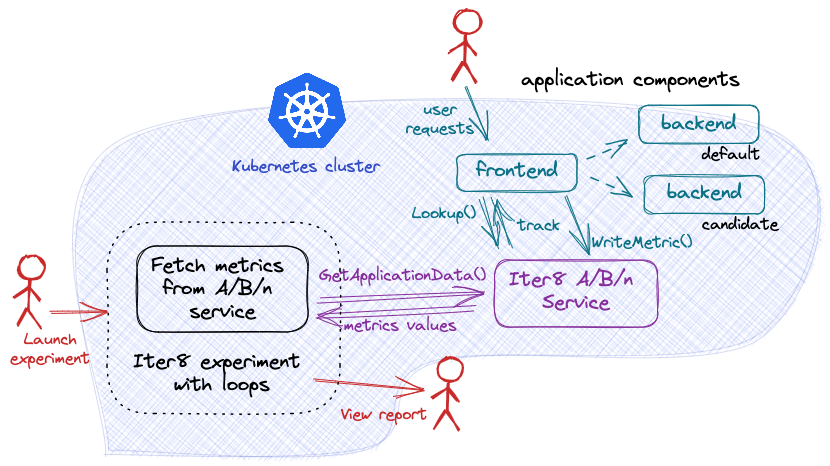A/B Experiments¶
This tutorial describes an A/B testing experiment for a backend component.

Before you begin
- Try your first experiment. Understand the main concepts behind Iter8 experiments.
Launch Iter8 A/B/n service¶
Deploy the Iter8 A/B/n service. When deploying the service, specify which Kubernetes resource types to watch for each application. To watch for versions of the backend application in the default namespace, configure the service to watch for Kubernetes service and deployment resources:
helm install --repo https://iter8-tools.github.io/iter8 iter8-abn abn \
--set "apps.default.backend.resources={service,deployment}"
Assumptions
To simplify specification, Iter8 assumes certain conventions:
- The baseline track identifier is the application name
- Track identifiers associated with candidate versions are of the form
<application_name>-candidate-<index> - All resource objects for all versions are deployed in the same namespace
- There is only 1 resource object of a given type in each version
- The name of each object in the version associated with the baseline track is the application name
- The name of each object in the version associated with a candidate track is of the form
<application_name>-candidate-<index>where index is 1, 2, etc.
Deploy the sample application¶
Deploy both the frontend and backend components of the application as described in each tab:
Install the frontend component using an implementation in the language of your choice:
kubectl create deployment frontend --image=iter8/abn-sample-frontend-node:0.13
kubectl expose deployment frontend --name=frontend --port=8090
kubectl create deployment frontend --image=iter8/abn-sample-frontend-go:0.13
kubectl expose deployment frontend --name=frontend --port=8090
The frontend component is implemented to call Lookup() before each call to the backend component. The frontend componet uses the returned track identifier to route the request to a version of the backend component.
Deploy version v1 of the backend component, associating it with the track identifier backend.
kubectl create deployment backend --image=iter8/abn-sample-backend:0.13-v1
kubectl label deployment backend app.kubernetes.io/version=v1
kubectl expose deployment backend --name=backend --port=8091
Generate load¶
Generate load. In separate shells, port-forward requests to the frontend component and generate load for multiple users. A script is provided to do this. To use it:
kubectl port-forward service/frontend 8090:8090
curl -s https://raw.githubusercontent.com/iter8-tools/docs/main/samples/abn-sample/generate_load.sh | sh -s --
Deploy a candidate version¶
Deploy version v2 of the backend component, associating it with the track identifier backend-candidate-1.
kubectl create deployment backend-candidate-1 --image=iter8/abn-sample-backend:0.13-v2
kubectl label deployment backend-candidate-1 app.kubernetes.io/version=v2
kubectl expose deployment backend-candidate-1 --name=backend-candidate-1 --port=8091
Until the candidate version is ready; that is, until all expected resources are deployed and available, calls to Lookup() will return only the backend track identifier. Once the candidate version is ready, Lookup() will return both track identifiers so that requests will be distributed between versions.
Launch experiment¶
iter8 k launch \
--set abnmetrics.application=default/backend \
--set "tasks={abnmetrics}" \
--set runner=cronjob \
--set cronjobSchedule="*/1 * * * *"
About this experiment
This experiment periodically (in this case, once a minute) reads the abn metrics associated with the backend application component in the default namespace. These metrics are written by the frontend component using the WriteMetric() interface as a part of processing user requests.
Inspect experiment report¶
Inspect the metrics:
iter8 k report
Sample output from report
Experiment summary:
*******************
Experiment completed: true
No task failures: true
Total number of tasks: 1
Number of completed tasks: 1
Number of completed loops: 3
Latest observed values for metrics:
***********************************
Metric | backend (v1) | backend-candidate-1 (v2)
------- | ----- | -----
abn/sample_metric/count | 35.00 | 28.00
abn/sample_metric/max | 99.00 | 100.00
abn/sample_metric/mean | 56.31 | 52.79
abn/sample_metric/min | 0.00 | 1.00
abn/sample_metric/stddev | 28.52 | 31.91
The output allows you to compare the versions against each other and select a winner. Since the experiment runs periodically, the values in the report will change over time.
Once a winner is identified, the experiment can be terminated, the winner can be promoted, and the candidate version(s) can be deleted.
To delete the experiment:
iter8 k delete
Promote candidate version¶
Delete the candidate version:
kubectl delete deployment backend-candidate-1
kubectl delete service backend-candidate-1
Update the version associated with the baseline track identifier backend:
kubectl set image deployment/backend abn-sample-backend=iter8/abn-sample-backend:0.13-v2
kubectl label --overwrite deployment/backend app.kubernetes.io/version=v2
Cleanup¶
Delete sample application¶
kubectl delete \
deploy/frontend deploy/backend deploy/backend-candidate-1 \
service/frontend service/backend service/backend-candidate-1
Uninstall the A/B/n service¶
helm delete iter8-abn